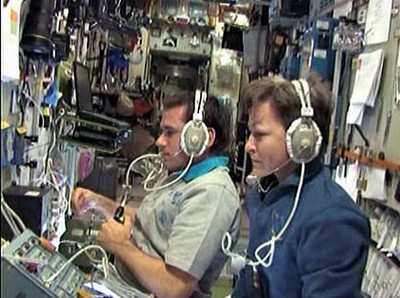Wed, Apr 02, 2008
Maneuvers Close To ISS, No Need For Abort Button
The Expedition 16 crew of the International Space Station
returned to science and station maintenance activities Tuesday
after Monday’s successful test approach of the Jules Verne
Automated Transfer Vehicle (ATV).

Commander Peggy Whitson and Flight Engineer Garrett Reisman
worked together to set up equipment for a periodic physical fitness
evaluation. Reisman exercised on the station’s cycle
ergometer while wearing a heart rate monitor. Whitson collected
data from this session, which exercise physiologists and flight
surgeons will use to assess Reisman’s health and make
adjustments to his exercise regimen if needed.
Later, Reisman worked in the Quest airlock, performing
maintenance on the cooling loops of the US spacesuits.
In preparation for the ATV docking on Thursday, Flight Engineer
Yuri Malenchenko checked the hardware needed to perform leak checks
in the event of a failure in the power unit of the cargo
carrier’s depress valve.
The Jules Verne approached the station on Monday for its "Demo
Day 2" practice maneuvers. It moved to within 36 feet of the Zvezda
Service Module in a rehearsal for docking on Thursday.
"All of today's activities went by the book. No issues," NASA
spokesman Rob Navias told Florida Today. "All of that activity
functioned as advertised."

The ATV reached its closest point to the station at 1238 EDT, at
which time it was commanded by the crew to retreat to a point 62
feet away. From there it executed an "escape" command to depart the
station for its three-day phasing prior to final approach and
docking around 1041 EDT Thursday.
Should Jules Verne fail to perform as planned during Thursday's
docking, astronauts onboard the ISS may hit a prominent "Abort"
button intended to signal the ATV to move away from the station,
and park itself in sleep mode until the problem can be found and
corrected. Fortunately, Monday's test showed the ISS crew, and
controllers on the ground in Houston, Russia, and the EU, that
button likely won't be needed.
More News
Airport Marking Aids Markings used on runway and taxiway surfaces to identify a specific runway, a runway threshold, a centerline, a hold line, etc. A runway should be marked in ac>[...]
"It is extremely difficult, if not impossible, for manned aircraft to see a drone while conducting crop-enhancing and other aerial applications at low altitudes and high speeds. We>[...]
Aero Linx: The Skyhawk Association The Skyhawk Association is a non-profit organization founded by former Skyhawk Pilots which is open to anyone with an affinity for the A-4 Skyhaw>[...]
“The T-54A benefits from an active Beechcraft King Air assembly line in Wichita, Kansas, where all required METS avionics and interior modifications are installed on the line>[...]
Aero Linx: Aerostar Owners Association The Association offers the Aerostar Owner a unique opportunity to tap an invaluable source of information concerning the care and feeding of >[...]
 ANN's Daily Aero-Term (04.28.24): Airport Marking Aids
ANN's Daily Aero-Term (04.28.24): Airport Marking Aids Aero-News: Quote of the Day (04.28.24)
Aero-News: Quote of the Day (04.28.24) ANN's Daily Aero-Linx (04.28.24)
ANN's Daily Aero-Linx (04.28.24) Aero-News: Quote of the Day (04.29.24)
Aero-News: Quote of the Day (04.29.24) ANN's Daily Aero-Linx (04.29.24)
ANN's Daily Aero-Linx (04.29.24)




